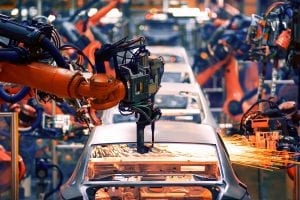What Does World Class Manufacturing Look Like in a Connected Worker World?
World Class Manufacturing (WCM) is the latest of the “XPS” production frameworks, launched in 2005 with the main objectives of increasing quality and reducing production costs. WCM was invented by FIAT and Hajime Yamashina, Professor Emeritus at Kyoto University in Japan, and is the latest continuous improvement approach driving the tenets of many new company production systems. It is now deployed in 162 plants at FIAT Chrysler Automobiles, but has been adopted widely by many prominent manufacturers, including Unilever and Atlas Copco.
WCM has the following 20 operational and managerial principles, many of which would be familiar to those who have been part of a continuous improvement initiative. The bolded pillars stand out as key principles that benefit the most from industrial work technologies available today, and will be further explored in this post.
|
|
|
|
WCM borrows heavily from Total Quality Management (TQM), Six Sigma, Lean, Total Productive Maintenance (TPM), 5S, and Just In Time (JIT), but has a few new and unique principles worth considering, given how quickly they could be further advanced by modern technology for orchestrating industrial work.
The following WCM concepts stand out as net-new focus areas, beyond the treatments of principles common to other quality and continuous improvement standards that came before it:
Starting with a Model Area
Many quality and continuous improvement standards have been cast as “Big Bang” events applied to a whole plant or company. WCM advocates starting with a test area in a plant to make it the exemplar. This presentation shows how the British post office, the Royal Mail, selected their model area. WCM guides that you should choose the worst-performing area or machine for this effort as a way to catalyze support for the WCM initiative.
Utilizing Cost Deployment
If you are familiar with activity-based costing that is part of the TQM toolkit, WCM advocates applying a similar approach to production. The goal is to shine a light on waste and then prioritize improvements where waste is most severe.
Embracing the Concept of Zero
WCM is designed to be thought of as a journey, not a destination. The mantra is zero waste, zero defects, zero breakdowns and zero inventory. In fact, Professor Yamashina was quoted as saying “zero is a beautiful number.” While true zero is almost impossible, these goals form a driving principle.
Driving to Autonomous Maintenance
Autonomous maintenance is borrowed from TPM, which has many similarities with WCM. Reliability Web defines autonomous maintenance as “a maintenance strategy wherein machine adjustments and minor maintenance is performed by operators who are deemed to have unique knowledge about the equipment.”
Let’s now look at each of these key aspects to evaluate how – nearly two decades after WCM was created – modern industrial software could dramatically accelerate the impact of WCM. Specifically, modern digital tools for orchestrating industrial work, like a Connected Worker Platform, puts procedures, collaboration, analytical insight and structured feedback in the hands of workers via mobile devices, and such platforms could significantly improve results for these key tenets of WCM.
Model area
One criticism of the model area concept – taking the worst area of the factory and making it the exemplar – is that 1) it is hard to scale, and 2) these end up as “islands of excellence” in an otherwise business-as-usual factory. This is arguably a traditional view where it can be hard to “lift and shift” hard-won best practice to new areas.
However, this is an area where a Connected Worker Platform really excels, as best practices can be captured in procedures and then easily ported to other work groups digitally, ultimately improving the competence of all teams. A critical benefit here is that new areas also can contribute to the state of the art by submitting issues and suggestions to improve processes. These submissions get actioned because they are tracked. As they are actioned, workers are likely to increase their pride of work ownership. (motivation of operators – WCM managerial pillar #10)
Cost deployment
Cost deployment (WCM technical pillar #2), like its predecessor activity-based costing, is a brilliant way to bring focus to improvements by ranking them based on their financial magnitude. Activity-based costing struggled because it was just so hard to achieve; if you apply costs to absolutely everything, your accounting overhead becomes almost unmanageable.
In the modern era, cost deployment benefits from Connected Worker technologies because they reveal what is broken without having to analyze everything – the data is summarized through analytics. (Level of detail – WCM managerial pillar #8) In a Connected Work environment, data is collected on every step in every procedure that is executed. If a step is going too slow, there is likely a problem. If procedural steps are not followed in order, there is likely a problem. You can then use the timestamps of each action to calculate the cost of defects, and then use that calculated cost to prioritize what to address first. This brings the concept of cost deployment into practical reach for more companies.
Concept of zero
Just to recap, zero here means zero waste, zero defects, zero breakdowns and zero inventory. If tracked manually, there is significant overhead to the point where it becomes just a vision and not a practical reality. With Connected Work, procedures are designed to be actively used in the workplace as workers complete them. This reduces waste and defects, and also prompts workers to really own the procedure and make adjustments to it through feedback. As a result, there is a direct impact on quality. (Quality control – WCM technical pillar #6) The procedure they are clicking through on a mobile device is actively tied to the work they are doing, not part of a distant memory of a training course they once took. This tenet also directly impacts improvement (focused improvement – WCM technical pillar #3), which, in turn, impacts the larger team and operation as a whole (competence of organization toward improvement – WCM managerial pillar #6).
Zero Inventory also is the goal of JIT, or Kanban manufacturing. It is very difficult to achieve when every supplier works independently. A Connected Worker Platform can be applied to the extended supply chain so that wait times can be minimized as each entity’s work completion signals the work of the next group in the chain, whether they work under the same roof or not. This directly impacts the way resources are properly allocated. (Time and budget – WCM managerial pillar #7)
Autonomous maintenance
The theory of autonomous maintenance that was introduced as a key part of TPM makes a lot of sense. It predates WCM – at least in concept – but in many ways WCM is reviving a focus on it. The theory is that workers who have intimate knowledge of the machines they work with every day do the routine maintenance. (Autonomous maintenance – WCM technical pillar #4a) As an example, in a Post cereal plant we visited, a supervisor mentioned that a wheel on the conveyor attached to one of their baking units needed to be treated with mineral oil every day, or the machine would break down. If this plant practiced autonomous maintenance, workers will have to remember to do this every day, day in and day out. The reality is, there’s a decent chance someone will forget to complete this mundane but important task during a busy shift, leading to a significant equipment failure.
Connected Worker solutions solve this challenge by scheduling every task so workers remember to do them. These workers also have detailed instructions, including pictures and video, allowing more of the maintenance to be done by line workers versus maintenance professionals. (People development – WCM technical pillar #9) This means more maintenance gets done more consistently, ultimately reducing breakdowns. (Competence of organization toward improvement – WCM managerial pillar #6)
Conclusion
It could be argued that WCM is the most comprehensive of the quality and continuous improvement approaches, as it benefited from and absorbed most of what came before it. As recent as it is, it can still make another giant leap forward as manufacturing now finds itself in the middle of the Fourth Industrial Revolution, with a new generation of modern digital tools like Connected Worker technologies that make manufacturing more productive and precise, providing organizations with the crucial ability to truly drive WCM.
Combining WCM with a Connected Worker Platform is an ideal way to make the more theoretical goals of WCM significantly more practical, measurable and achievable. The level of detailed and granular data that can be extracted from day-to-day operations can then be used to improve team and employee learning, which increases confidence and motivation. These impacts are most prominent in the bolded areas above. Managerial insights impact technical skills, which in turn provide more managerial insight. Ultimately, these separate lists become a dynamic system where the interplay between managerial wins and technical wins accelerate overall improvement, quality and the motivation to repeat this level of excellence every day.







